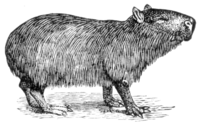Rodent
|
|
| Rodents | ||||||||
|---|---|---|---|---|---|---|---|---|
 Capybara, the largest living rodent | ||||||||
| Scientific classification | ||||||||
| ||||||||
| Families | ||||||||
|
Many, see text |
The order Rodentia is the most numerous of all the branches on the mammal family tree. Currently there are, depending on the authority consulted, between 2000 and 3000 species of rodent—roughly half of all mammal species. Rodents are found in vast numbers on all continents except Antarctica (they are the only placental order other than the bats to reach Australia without human introduction), most islands, and in all habitats bar the oceans.
Most rodents are small. The tiny African Pygmy Mouse is only 6 cm in length and 7 grams in weight. On the other hand, the Capybara can weigh up to 45 kg (100 pounds) and the extinct Phoberomys pattersoni is believed to have weighed 700 kg.
Rodents have two incisors in the upper as well as in the lower jaw which grow continuously and must be kept worn down by gnawing; this is the origin of the name, from the Latin rodere, to gnaw. These teeth are used for cutting wood, biting through the skin of fruit, or for defence. These teeth have enamel on the outside and exposed dentine on the inside, so they self-sharpen during gnawing. Rodents lack canines, and have a space between their incisors and premolars. Nearly all rodents feed on plants, seeds in particular, but there are a few exceptions which eat insects or even fish.
Rodents are important in many ecosystems because they reproduce rapidly, and can function as food sources for predators, mechanisms for seed dispersal, and as disease vectors. Humans use rodents as a source of fur, as a model organism in animal testing, and even in detecting landmines[1] (http://www.theage.com.au/articles/2004/05/18/1084783512636.html?oneclick=true).
Classification
The rodents are part of the clades: Glires (along with lagomorphs), Euarchontoglires (along with lagomorphs, primates, tree shrews, and colugos), and Boreoeutheria (along with most other placental mammals). The order Rodentia may be divided into suborders, infraorders, superfamilies and families. This is a common classification scheme:
- ORDER RODENTIA
- Suborder Sciurognathi
- Infraorder Sciurida
- Family Sciuridae: squirrels, including chipmunks & prairie dogs
- Family Aplodontiidae: mountain beaver
- Infraorder Castorimorpha
- Family Castoridae: beavers
- Infraorder Anomaluromorpha
- Family Anomaluridae: scaly-tailed squirrels
- Family Pedetidae: springhares
- Infraorder Ctenodactylomorpha
- Family Ctenodactylidae: gundis
- Infraorder Glirimorpha
- Infraorder Geomorpha
- Family Geomyidae: pocket gophers (true gophers)
- Family Heteromyidae: kangaroo mice
- Infraorder Myodonta
- Superfamily Dipodoidea
- Superfamily Muroidea
- Family Platacanthomyidae: spiny dormice
- Family Spalacidae: mole rats, bamboo rats, and zokors
- Family Calomyscidae: mouse-like hamsters
- Family Nesomyidae: climbing mice, rock mice, white-tailed rat, Malagasy rats and mice
- Family Cricetidae: hamsters, New World rats and mice, voles
- Family Muridae: true mice and rats, gerbils, spiny mice, crested rat
- Infraorder Sciurida
- Suborder Hystricognathi
- Family Laonastidae: Laotian rock rat
- Family Hystricidae: Old World porcupines
- Family Erethizontidae: New World porcupines
- Family Thryonomyidae: cane rats
- Family Bathyergidae: African mole rats
- Infraorder Caviomorpha
- Family Octodontidae: octodonts
- Family Echimyidae: spiny rats, including nutrias
- Family Capromyidae: hutias
- Family †Heptaxodontidae: giant hutias
- Family Myocastoridae: nutria
- Family Dasyproctidae: agoutis
- Family Dinomyidae: pacaranas
- Family Caviidae: cavies, including guinea pigs
- Family Hydrochoeridae: Capybara
- Family Chinchillidae: chinchillas and viscachas
- Family Abrocomidae: chinchilla rats
Alternate Classifications
The above taxonomy uses the shape of the lower jaw (sciurognath or hystricognath) as the primary character. This is the most commonly used approach for dividing the order into suborders. Many older references emphasize the zygomasseteric system (suborders Protrogomorpha, Sciuromorpha, Hystricomorpha, and Myomorpha).
Several molecular phylogenetic studies have used gene sequences to determine the relationships among rodents, but these studies are yet to produce a single consistent and well-supported taxonomy. Some clades have been consistently produced such as:
- Ctenohystrica contains:
- Ctenodactylidae (gundis)
- Hystricognathi containing:
- Hystricidae
- An unnamed clade containing:
- An unnnamed clade contains:
- Gliridae
- Sciuroidea containing:
- Myodonta includes:
The positions of the Castoridae, Geomyoidea, Anomaluridae, and Pedetidae are still being debated.
References
- Adkins, R. M. E. L. Gelke, D. Rowe, and R. L. Honeycutt. 2001. Molecular phylogeny and divergence time estimates for major rodent groups: Evidence from multiple genes. Molecular Biology and Evolution, 18:777-791.
- Nowak, R. M. 1999. Walker's Mammals of the World, Vol. 2. Johns Hopkins University Press, London.
- Steppan, S. J., R. A. Adkins, and J. Anderson. 2004. Phylogeny and divergence date estimates of rapid radiations in muroid rodents based on multiple nuclear genes. Systematic Biology, 53:533-553.
| Mammals |
|---|
| Monotremata |
|
Placentalia: Xenarthra | Dermoptera | Desmostylia | Scandentia | Primates | Rodentia | Lagomorpha | Insectivora | Chiroptera | Pholidota | Carnivora | Perissodactyla | Artiodactyla | Cetacea | Afrosoricida | Macroscelidea | Tubulidentata | Hyracoidea | Proboscidea | Sirenia |
|
Marsupialia: Didelphimorphia | Paucituberculata | Microbiotheria | Dasyuromorphia | Peramelemorphia | Notoryctemorphia | Diprotodontia |
da:Gnavere de:Nagetiere eo:Ronĝuloj fr:Rongeurs he:מכרסמים ko:설치류 li:Knaagdiere nl:Rodentia ja:ネズミ目 pl:Gryzonie sk:Hlodavce fi:Jyrsijät sv:Enkeltandade gnagare zh:啮齿目
